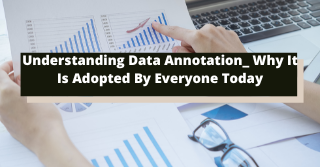Data annotation services are making a lasting impression, with many companies seeing them as the better solution to data processing outsourcing. However, what is data annotation? What are all the benefits and how is it being implemented as a revolutionary trend across industries? Let’s take a closer look at this trend with this article!
What is Data Annotation?
Data annotation is a process of tagging data with metadata in order to make it more easily understood and analyzeable. This metadata can include information about when the data was collected, what resources were used to create it, and other contextual information.
Data annotation is often adopted by organizations because it enables them to make better decisions about how to use data, who should have access to it, and how best to manage and use it. It also allows for more accurate tracking and analysis of data over time.
Benefits of using Data Annotation Services
Data annotation is a powerful way to organize and manage data. It can be used to make data more manageable, searchable, and transparent. The benefits of using data annotation services include the following:
– Improved Data Management: Kenya data annotation services can help you collect and manage data in a more organized way. This makes it easier for you to find information, understand how your data is used, and make changes to it.
– Increased Visibility: Data annotation can make your data more visible to others. This means that they can more easily find the information that they need and use it correctly.
– Improved Searchability: Data annotation can help you find specific information quickly and easily. This makes it faster and easier for you to find the information that you need.
– Improved Transparency: Data annotation can help you make your data more transparent. This means that you can easily see how your data is used and change it if necessary.
Why Use it?
Understanding data annotation is slowly becoming the norm for businesses and organizations of all sizes due to the immense benefits it has to offer. Here are some key reasons why data annotation is adopted by everyone today:
-Annotations provide context and meaning to data, making it more user friendly.
-With annotations, users can easily see relationships between different pieces of data and make better decisions.
-Annotations can help users uncover insights and patterns in their data that they may not have noticed before.
-Annotations can help stakeholders make informed business decisions.
How It Works:
Understanding data annotation is important for anyone working with big data. This process is a way of adding additional information to data so that it can be more easily understood and used. Data annotations provide a way for people to share their insights and interpretations of the data, making it more useful and valuable to others.
Data annotation can be used in a number of different ways. For example, it can be used to add extra information about the contents of a dataset so that it can be more easily understood. This can make it easier for people to find the information they need, and it can also help them understand how the data was collected and processed. Data annotation can also be used to add additional information about the purpose of the dataset. This can help people identify specific areas of interest, and it can also help them better understand how the data is related to other datasets.
Data annotation is becoming increasingly popular because it provides a way for people to add extra information to data without having to modify or re-create it. This means that datasets can be shared more easily, which makes them more accessible and useful. Moreover, data annotation is an effective way of communicating your insights about the data to others.
Some Examples of Data Annotation Services
Data annotation is the process of attaching metadata to datasets. This metadata includes information such as the dataset’s name, the source of the data, and any notes or explanations about the data. As data becomes increasingly complex and diverse, it becomes important for managers and analysts to have access to metadata that accurately describes the data. This is where data annotation services come in handy.
Data annotation services allow users to annotate their datasets with specific metadata. Once annotations are added, these services make the annotations available to other users or software programs. In this way, data annotation services allow users to collaborate on datasets and share information about them quickly and easily. Additionally, data annotation services can help analysts understand datasets better by revealing any unknown information or inconsistencies within the data.
In recent years, data annotation services have become very popular because they provide a number of benefits to users. First, data annotation services allow users to share datasets more easily by providing a mechanism for attaching metadata to them. Additionally, data annotation services can help analysts understand datasets better by revealing any unknown information or inconsistencies within them. Finally, data annotation services can also be used to improve workflow processes by assisting managers and analysts with the organization of their data files.
Conclusion
In this article, we will be discussing the basics of data annotation and what it can do for you. We will look at some of the most popular applications that use data annotation to enhance their user experience, as well as detail why everyone is adopting it today. So if you’re looking to get ahead in your field or just want to make life a little easier for yourself, understanding data annotation is key.
